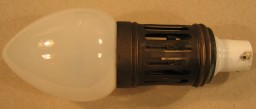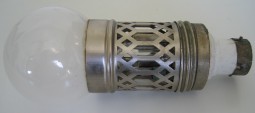

Nernst lamps AEG: model A, model B (left), model D (right),
AEG advertisements. Die Woche 5 (1903) no. 48, p. VI, 1903-11-28; EM (1906) no. 28, p. VIII, 1906-07-12
German booklet (c. 1903), French booklets (1905 and 1907)
Multiple Nernst Lamp (three lamps in one fitting), Express Nernst Lamp
Multiple Nernst Lamp, Outside Lantern
The AEG stopped production of ordinary Nernst lamps in 1909. The total production was about eight million lamps. However, Nernst glowers for replacement and for special purposes (e.g., projection) were still produced.
The AEG at the Paris exposition 1900 (flyer)
Paris exposition 1900: Palais de l'Electricité & Chateau d'Eau (postcards)
Landesmuseum Mannheim: Nernst lamp
Science & Society Picture Library, Science Museum, London: Nernst lamp
Bulbmuseum Kralupy nad Vltavou: Nernst lamp
Initial public offering (The Times. Monday, February 27th, 1899)
Nernst lamp, Nernst Lamp Company, Pittsburgh (c. 1903)
The right photograph shows details of the heaters (large rods) and of the glowers (small
rods).
Label with patent information
Nernst lamp, Nernst Lamp Company, Pittsburgh (c. 1903)
Replacement holders (glower and heater) (1904 and 1905)
The Nernst Lamp Company's Works
Garrison Place and Fayette Street, Pittsburgh, Pa.
Nernst Lamp Company, Pittsburgh. Booklets (1903 and 1909)
Nernst Lamp Company, Pittsburgh. Advertisements
In the United States, George Westinghouse undertook the commercial development and introduction of the Nernst lamp. In 1901 the Nernst Lamp Company was organized and took up its quarters in Pittsburgh in a five-story factory building with a total floor area of 101,000 square feet. Yttria (Y2O3) was obtained from the mineral gadolinite which the company extracted from its own mine at the legendary Barringer Hill, Texas (since 1937 buried beneath the waters of Lake Buchanan, Colorado River). By 1904 a total of over 130,000 Nernst glowers had been placed in service throughout the country.
However, the Nernst lamp lost competition when the more convenient incandescent light bulbs containing a metal (e.g., tungsten) filament and filled with an inert gas (e.g., argon) became available soon after (Irving Langmuir [a PhD student of Nernst], General Electric Company, 1913). The Barringer Hill mine closed for good in 1906.
The Nernst glower is a continous source of (near) infrared radiation used in spectroscopy. Typically it is in the form of a cylindrical rod or tube composed of a mixture of certain oxides (e.g., zirconium oxide ZrO2, yttrium oxide Y2O3 and erbium oxide Er2O3 at a ratio of 90:7:3 by weight) and it is electrically heated to about 2000 °C. Initially it requires external heating because it is an insulator at room temperature.
Nowadays, a more commonly used infrared source is a similar glow bar (= globar) made of silicon carbide SiC and operated at about 1100 °C. The globar does not require external initial heating as it conducts electricity at all temperatures. It is also better suited for use in an evacuated system.
Nernst lamps were used in the transmitter (scanner) and in the receiver (photo printer) of the first practical long-distance photoelectric facsimile system (fax) designed by professor Arthur Korn (1870 - 1945), München in 1902.
References:
A. Korn. Phys. Z.
A. Korn. Elektrische Fernphotographie und Ähnliches. Verlag von S. Hirzel, Leipzig, 1904,
66 pp. (2nd ed., 1907, 87 pp.)
References:
Gebrauchsanweisung für die Nernstlampen nach Greil.
Carl Zeiss, Jena, 1909, 6 pp.
Nernstlampe als Mikroskopierlampe
(Mikro-Nernstlampe). Carl Zeiss, Jena, 1911, 9 pp.
The Swedish ophthalmologist Allvar Gullstrand (1862 - 1930) utilized the Nernst lamp in his invention of the slit lamp (1911) which acquired great importance as a diagnostic instrument for the eye.
Nouvelle lampe électrique. L'Illustration, ann. 56, vol. 112, no. 2890, 1898-07-16, p. 46
H. Monmouth Smith. The Nernst Lamp. Science 1898-11-18, pp. 689 - 690
H. C. Cooper. The Nernst Light. Science 1898-11-18, p. 710 (correspondence)
The Nernst Light. Scientific American 80 (1899) 150, 1899-03-11
James Swinburne. [paper presented before the Society of Arts, London]. Scientific American Supplement (1899)
Die Nernst-Lampe der Allgemeinen Elektrizitäts-Gesellschaft, Berlin.
Polytechnisches Journal 312 (1899) 197 - 199
dingler.culture.hu-berlin.de/article/pj312/ar312049
Die Nernst'sche Glühlampe. Elektrotechnische Zeitschrift 20 (1899) 355 - 356
Franz Bendt. Die Nernstlampe. Die Gartenlaube 1899, no. 30, pp. 508, 510
Franz Bendt. Zwei neue Lampen von Edison und von Auer von Welsbach. Die Gartenlaube 1899, no. 37, p. 623
Nernst Lamp at the [Paris] Exposition. Scientific American 83 (1900) 138, 1900-09-01
Franz Bendt. Die Vollendung der Nernstlampe. Die Gartenlaube 1901, no. 16, 391 - 392
E. Ruhmer. Über die auf der "Internationalen Ausstellung für Feuerschutz und
Feuerrettungswesen, Berlin 1901" ausgestellten elektrischen Apparate.
Physikalische Zeitschrift 2 (1901) 629 - 634 and 642 - 646
Excerpt related to the Nernst lamp (with 7
figures)
High-candlepower Nernst Lamps. Western Electrician 28 (1901) 353. Excerpt (with 3 figures)
Murray C. Beebe. Nernst Lamp. The National Engineer 6 (1902) 1 - 4
Nernst Lampe. Allgemeine Elektricitäts-Gesellschaft, Berlin, c. 1903, 38 pp.
The Nernst Lamp. Nernst Lamp Co., Pittsburgh, Pa., 1903. Special Publication N-7000, 24 pp. (cover, JPG, 343 KB)
The Nernst Lamp. Catalogue No. 2. Nernst Lamp Co., Pittsburg, Pa., January, 1903. 32 pp. (cover, JPG, 234 KB)
The Nernst Lamp Instruction Book. No. 2. Nernst Lamp Co., Pittsburg, Pa., January, 1903 (2nd ed.). 20 pp. (facsimile, PDF, 1.2 MB)
Leon W. Hartmann. A Spectrophotometric Study of the Luminous Radiation from the Nernst Lamp Glower under Varying Current Density. Phys. Rev. 17 (1903) 65 - 90 (Physical Review Online Archive)
L.R. Ingersoli. On the Radiant Efficiency of the Nernst Lamp. Phys. Rev. 17 (1903) 371 - 377 (Physical Review Online Archive)
Nernst Lamp Company. In: American institute of electrical engineers, The Pittsburg
electrical hand-book; being a guide for visitors from abroad attending the International
electrical congress, St. Louis, Mo., September, 1904, pp. 127 - 131
http://www.archive.org/details/pittsburgelectri00amer
Die Nernstlampe. Miniatur-Bibliothek. Heft Nr. 221. Erfindungen und Entdeckungen. Verbesserte und vermehrte Auflage. Verlag für Kunst und Wissenschaft. Albert Otto Paul. Leipzig, c. 1905. 47 pp.
Lampes "Nernst", 1905. 26 pp. (cover, JPG, 116 KB)
Leon W. Hartmann. Concerning the Temperature of the Nernst Lamp. Phys. Rev. 22, 351 - 356 (1906) (Physical Review Online Archive)
Lampes "Nernst", 1907. 40 pp. (cover, JPG, 136 KB)
The Westinghouse Nernst Lamp. Bulletin "A". Nernst Lamp Co., Pittsburg, Pa., 3rd ed., April, 1909. 30 pp. (cover, JPG, 264 KB)
L. Graetz: Die Elektrizität und ihre Anwendungen. Verlag von J. Engelhorn, Stuttgart.
15th ed., 1910. 690 pp.
Excerpt related to the Nernst lamp (with 3
figures)
Th. Schwartze. Licht und Kraft. Union Deutsche Verlagsgesellschaft, Stuttgart, 10th -
13th ed., 1914. 631 pp.
Excerpt related to the Nernst lamp
(with 4 figures)
Felix Pinner. Emil Rathenau und das elektrische Zeitalter. Akademische
Verlagsgesellschaft m. b. H., Leipzig, 1918. 408 pp.
Excerpts related to the Nernst lamp
Artur Fürst. Das elektrische Licht. Albert Langen, München, 1926. 222 pp.
Carl Wagner, Über den Mechanismus der elektrischen Stromleitung im Nernststift. Die Naturwiss. 31 (1943) 265 - 268
Nernst-Lampe. In: E[manuel] Rosenberg, Der Werdegang eines Ingenieurs. Springer-Verlag, Wien, 1950. Pp. 65 - 67
Hans-Georg Bartel, Gudrun Scholz and Fritz Scholz. Die Nernst-Lampe und ihr Erfinder. Z. Chem. 23 (1983) 277 - 287
Jean Hackett and Robert Wilkes. The Story of Barringer's Hill
http://home.satx.rr.com/robnjean/bh/story.html
Barringer Hill. In: Richard Zelade. Lone Star Guide: Hill Country
http://www.texasescapes.com/FEATURES/Richard_Zelade_Hill_Country/Barringer_Hill_Lake_Buchanan.htm
Frank Andrews. A Short History of Electric Light (2003)
http://www.debook.com/
Revised 2023-08-16